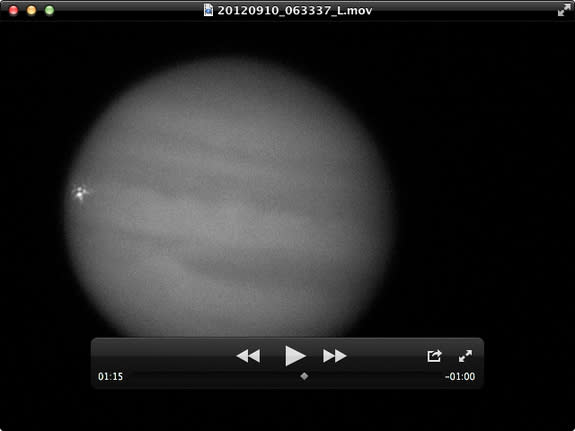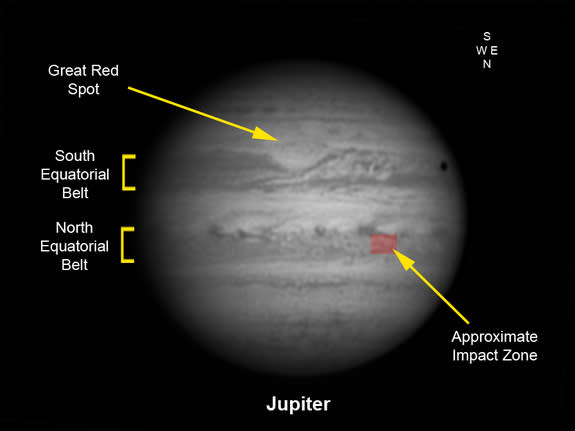Explosion on Jupiter Spotted by Amateur Astronomers
An apparent impact on Jupiter early Monday (Sept. 10) created a fireball on the planet so large and bright that amateur astronomers on Earth spotted the flash.
The surprising impact on Jupiter was first reported by amateur astronomer Dan Peterson of Racine, Wisc., who was observing the largest planet in our solar system when the event occurred, according to the website Spaceweather.com, which tracks space weather and night sky events.
"It was a bright flash that lasted only 1.5 – 2 seconds," Peterson told Spaceweather.com. Peterson used a Meade 12-inch LX200GPS telescope to observe the event, which occurred near the southern edge of Jupiter's northern equatorial belt of clouds.
In a report posted on the Cloudy Nights forum, Peterson said it wasn't clear if the impact would leave a scar on Jupiter much like those seen in 1994, when the comet Shoemaker-Levy 9 broke into pieces and peppered the planet with debris, creating visible impact marks in Jovian cloud tops. It is also not yet known if the object to strike Jupiter was a small asteroid or comet.
"My best guess is that it was a small undetected comet that is now history, hopefully it will sign its name on Jupiter's cloud tops," Peterson wrote.
In Dallas, Texas, amateur astronomer George Hall read Peterson's initial report on an online Jupiter-observing forum.
"When I saw the post, I went back and examined the videos that I had collected this morning," Hall wrote on his night sky photography website on Monday.
Sure enough, Hall had captured a video of the Jupiter impact and reported that it occurred at 6:35 a.m. CDT (1335 GMT) on Sept. 10. He used a 12-inch LX200GPS telescope equipped with a 3x Televue Barlow and Point Grey Flea 3 camera.
"The popularity of modern digital imaging combined with the tenacity and hard work of dedicated planetary observers has paid off yet again with a visual report of a fireball event in Jupiter's atmosphere being reported visually and then being confirmed by stills from a movie sequence," astronomer and astrophotographer Pete Lawrence, a BBC night sky presented who runs the DigitalSky website, told SPACE.com in an email. "The fact that such events have now been reported before may be a catalyst for visual observers to keep watch for them."
Monday's Jupiter impact was the fourth report of objects striking Jupiter since July 2009, when amateur astronomers spotted a bruise the size of the Pacific Ocean in the planet's cloud tops after an apparent asteroid strike on the planet.
Two more Jupiter impact events were reported in 2010 by night sky observers, first in June and then again in August.
One of the most dazzling Jupiter impacts was the Shoemaker-Levy 9 comet crash in 1994. The comet broke into more than 20 pieces as it approached Jupiter, with each piece crashing into the giant planet. Astronomers used telescopes on the ground and in space to watch that event as it unfolded.
"The speed of modern communications also helps, and word of the impact spread around the internet with great rapidity," Lawrence said. "For those with a camera, the lure of imaging Jupiter just became that little bit more exciting!"
Editor's note: If you have a photo of Monday's impact on Jupiter, or any other amazing night sky photo that you'd like to share for a possible story or image gallery, please contact managing editor Tariq Malik at tmalik@space.com.
You can follow SPACE.com on Twitter @Spacedotcom. We're also on Facebook & Google+.
Copyright 2012 SPACE.com, a TechMediaNetwork company. All rights reserved. This material may not be published, broadcast, rewritten or redistributed.



